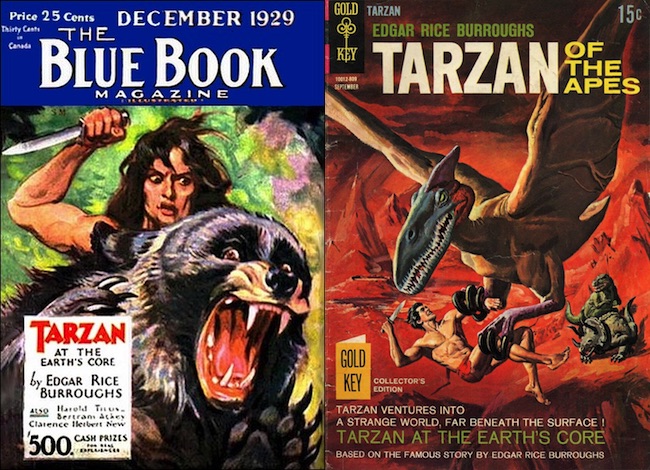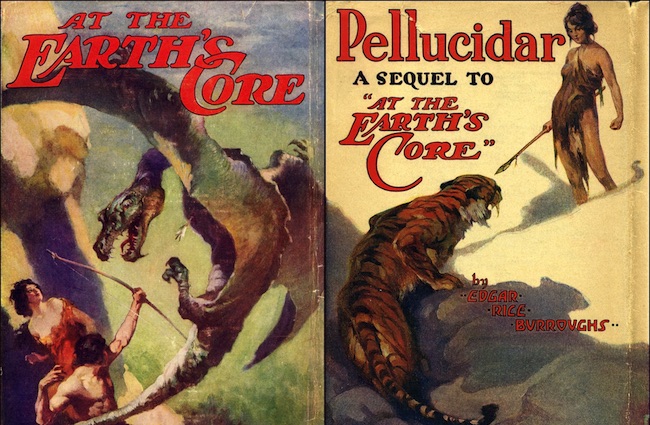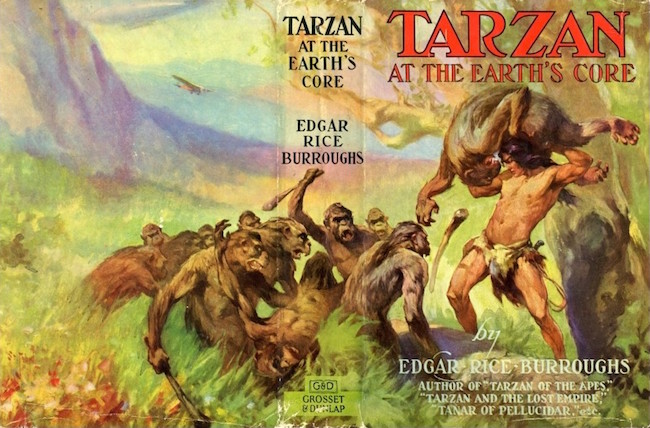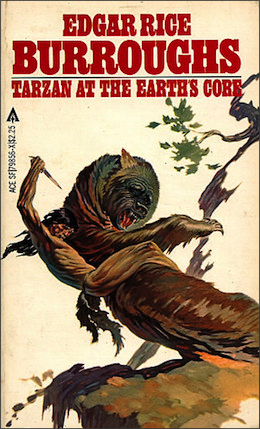In this bi-weekly series reviewing classic science fiction and fantasy books, Alan Brown looks at the front lines and frontiers of the field; books about soldiers and spacers, scientists and engineers, explorers and adventurers. Stories full of what Shakespeare used to refer to as “alarums and excursions”: battles, chases, clashes, and the stuff of excitement.
Edgar Rice Burroughs’ most popular creation was Tarzan the jungle lord, who had many fantastic adventures with strange creatures and lost cities. Tarzan’s strangest adventure, however, came when he crossed over into another Burroughs series, and visited a mysterious world in the center of the Earth: the land of Pellucidar. There he found dinosaurs and saber-tooth tigers, lizard men and pirates, cavemen and pterodactyls.
Hidden Treasures
There is one encounter I had with the works of Edgar Rice Burroughs that I will never forget. One of the big annual events in my hometown was our church auction. As each summer progressed, basements and barns of church members filled with donations. We sold books in box lots, and one year, when I was 11 or 12, I had the job of making up the boxes—and discovered some hidden treasures. Someone had donated a collection of Stratemeyer Syndicate and Edgar Rice Burroughs adventure books from the 1920s and 1930s (you can find a review of a typical Stratemeyer book here). I separated the ones that we didn’t already have in our basement and put them in the bottom of a box with some uninteresting books on top; a few cookbooks and something about a car called a Chilton Manual. This box was the one I would bid on in the auction.
But when the bidding began, I found I had a competitor. I had six dollars in my pocket, a hefty sum at that time, and all the money I had in the world. But I had bid five and was beginning to sweat before the man finally dropped out. For some reason, my plan had not worked out the way I had intended. As I was carrying off my box, he approached me, said he thought we were bidding for the box for different reasons, and offered me two dollars for the Chilton Manual. I happily agreed, and learned several lessons from the experience; that strangers can be kind, that a good negotiator can help both parties end up ahead, that not everyone puts the same value on the same thing, and that when you practice to deceive, you can be your own worst enemy. And in addition to those lessons, I had some great books to read during the rest of the summer.
My older brother was the big Tarzan fan in the family, but one particular Tarzan book caught my attention because of its fantastic setting—the book in which Tarzan traveled inside the Earth itself and had adventures that boggled my mind (adventures involving dinosaurs, a passion of mine in my younger years).
About the Author

Edgar Rice Burroughs (1875-1950) was born in Chicago, and before he became a writer, he dabbled in many professions, never with any success. He attended several schools, spent a short time as a trooper in the Seventh Cavalry, and in occupations as diverse as salesman, prospector, shopkeeper, cowboy and railroad cop. But he had a flair for storytelling, and enjoyed reading the pulps. Thinking he could do better than some of the other authors in those books, in 1911 he submitted the first John Carter story, “Under the Moons of Mars,” to All-Story Magazine. When the story sold, he knew he was on to something. The next year he created another character, Tarzan of the Apes, and he was on the road to fame and fortune. In addition to the jungles of Africa, his characters roamed the Earth, Mars, Venus, the Moon, and even the Earth’s interior. He was a pioneer in writing what became known as “planetary romances,” inspiring a sub-genre that filled many magazines with stories, and many young heads with dreams of adventuring on strange worlds. He was a pioneer in licensing his characters for appearance in other media, and Tarzan appeared in comic strips, in movies, and on the radio. While his fiction liberally uses the tools and tropes of pulp fiction, Burroughs was a master storyteller, with an unusually fertile imagination who wrote stories with tremendous energy. It is no wonder that he quickly rose head and shoulder above his peers.
Modern readers must be cautioned that Burroughs’ stories are influenced by the pervasive racism and sexism common in the era. Tarzan can be seen as an example of what has come to be called the “white savior” trope. Burroughs’ characters often jump to conclusions based on the race, sex, and appearance of other characters, persons of color are used for comic relief, and vicious conflict between races and tribes is portrayed. That being said, characters are also often shown rising above this prejudice, and while the women in his stories are generally there to provide his male protagonists with a love interest, they arguably exhibit more agency than women in many other stories of the era.
Tarzan

The most popular of all the characters Burroughs created, Tarzan was the very embodiment of what Burroughs considered the highest virtues of both civilization and nature. His adoption by apes followed in the tradition of many figures of legend, such as Romulus and Remus, founders of Rome, who were suckled by a wolf after being abandoned in a forest. Tarzan learned the ways of the jungle from his adopted tribe, and was intelligent enough to learn to read from the children’s primers and other books his shipwrecked parents left behind. He was at the peak of human conditioning and abilities, his strength honed by his jungle life. He was faithful to his wife, and constant in his desire to protect the weak and the helpless. He was chivalrous, and a fierce enemy when provoked. Those whose view of Tarzan was shaped primarily by the movies and Johnny Weissmuller’s incarnation of the character, with a limited vocabulary and simple worldview, are often surprised to meet the erudite and thoughtful Tarzan of the books.
Hollow Earth

Mankind has long been fascinated by the concept of another world beneath our feet. The idea of the land of the dead, or Hell, being underground is just one of many such legends. Jules Verne’s Journey to the Center of the Earth described adventurers finding massive caves full of strange plants and creatures deep below the surface. Starting in the late 17th Century, there was speculation that the Earth might be a shell, only a few hundred miles thick, with another world contained within. In the early 19th Century, an American named John Symmes put forward a theory that gained many followers, suggesting that not only was the Earth hollow, but that entrances to its interior could be found at the poles. Even into the 20th Century, as polar explorations found nothing of the sort and all scientific evidence pointed strongly against it, some people clung to the hollow earth idea.
Polar explorers of the time had their own odd theories. One persistent theory, which led many to their death, was that there existed an Arctic continent and a warm water ocean above a rim of ice. There were even those who called this continent Ultima Thule, after ancient writings that probably were, in actuality, describing Scandinavian lands. Some occult-obsessed Nazis even argued that this land was the source of their so-called “master race.”
In 1914, Burroughs saw the idea of a hollow earth as a fertile landscape for adventure. He wrote of a pair of explorers, David Innes and Abner Perry, who used a drilling machine to bore through the earth’s crust to find this mysterious land, which Burroughs called Pellucidar. They found a world with no horizons, because the surface curved upwards, and permanent daylight, with a small sun floating in its center. A small body near the sun created one small area of darkness. The continents and seas were a mirror image of what was found on the surface of Earth. And, capitalizing on the then-current interest in fossils and prehistoric creatures, Burroughs populated this world with dinosaurs and other holdovers from bygone eras on the surface. There were also pirates who had wandered in from the surface world, as well as all sorts of sentient creatures evolved from different animals. While a veneer of scientific explanation is given for the various wonders Innes and Perry find in Pellucidar, the science is of the “pseudo” variety, and these tales fall squarely into the realm of fantasy.
Tarzan at the Earth’s Core

The book opens with Tarzan investigating a party that has intruded on his jungle home, led by a young American inventor named Jason Gridley, who has recently received mysterious messages on a new type of radio. Gridley tells him of a mysterious world within the Earth, and how another American explorer, David Innes, has been captured and is in need of rescue. Gridley proposes that Tarzan co-sponsor an expedition that will use a dirigible to travel via the polar entrance to this world. Gridley is concerned that normal dirigibles need lots of ground support, but Tarzan has a better idea: a friend of his has discovered an incredibly light and strong material that could be used to build pressure vessels that could be pumped down to a vacuum, and provide even more lift than lighter-than-air gasses. (I suspect that this approach would require new physical laws rather than just a new material, but we are reading a book where the Earth is a giant hollow sphere, so let’s just accept that and move ahead.) Together, they go to Germany and commission the construction of this craft, which they dub the O-220. They hire a crew that consists of German airmen, an African-American cook, and Filipino stewards. Tarzan enlists ten Waziri warriors from his African homeland to defend the expedition. Oddly, the only person from this crew who displays any personality at all is Robert Jones, the cook, whose bemusement about the strange environment and perpetual noon is presented as a running joke. The others simply serve the plot as required.
The O-220 lands on a prairie, and Tarzan heads out to explore. Eventually, distracted by the strangeness of the land, he finds himself captured and hanging from a tree limb by a primitive snare. A saber-toothed tiger stalks him as he hangs there. Back at the O-220, Gridley decides to search for Tarzan, taking the Waziri as well as one of the German crew, Wilhelm von Horst. They follow game trails, and see all sorts of strange beasts. Soon they realize that the animals are being herded by a group of saber-toothed tigers. The tigers attack, and the group is scattered. Meanwhile, Tarzan is rescued from his own menacing tiger by a group of Neanderthal-like gorilla men. He is surprised to find that they speak the same language as the ape tribes of Africa. One of them, Tar-gash, is friendly to Tarzan, and when they take him to their village, Tarzan returns the favor by warning him against an attack by a rival. Both flee the village, and Tar-gash suggests that they go find Tarzan’s people. Bewildered by the odd terrain and the perpetual noonday sun, however, Tarzan soon realizes that, for the first time in his life, he is lost.
Gridley has been hiding in a tree since the tigers scattered his party, and eventually makes his way back to the O-220. He takes their single scout plane, but is attacked and brought down by a pterodactyl. Tarzan and his companion are heading toward a land where Tar-gash knows that people like Tarzan live, and they see the scout plane pass overhead. They are attacked by a giant flightless bird, and kill it with the assistance of a human warrior. Tar-gash wants to kill the man, whose name is Thoar, but Tarzan suggests that he can trust a man who just saved them, and they team up.
Meanwhile, a beautiful young woman, Jana, is being pursued by members of a tribe whose practice is to capture mates from outside the tribe. Jason Gridley, regaining consciousness after parachuting from his wrecked aircraft, sees her pursued by not only the four tribesmen, but also a pack of hyaenodons. Gridley draws his trusty Colt revolver and fights off both the creatures and the tribesmen. Together they find the remains of Gridley’s aircraft and he recovers a rifle and other gear; the plane, however, will never fly again. A short while later, Tarzan and his party find the aircraft, and Thoar recognizes the footprints of his sister, Jana. At the same time, Von Horst and the Waziri are lost in the wilds, and the O-220 sends out yet another search party—which, though unsuccessful, at least finds its way back to the airship.
Gridley and Jana learn each other’s language, and head back toward her people. They develop affection for each other, but when she confronts him about his feelings, he finds he can’t admit love of a savage, no matter how desirable. Jilted, she turns away from him, but he continues to follow, his mind in turmoil, his civilized notions of a proper mate warring with his natural inclinations. Tarzan is carried off by a pterodactyl to its nest, and Tar-gash and Thoar, thinking Tarzan is doomed, go their separate ways. Tarzan, being who he is, escapes from the nest. There is a cloudburst, and Jana thinks Gridley has been killed in the flooding that follows it. Tarzan sees a lost boy being attacked by a massive cave bear, and jumps in to the rescue. Meanwhile, Gridley, who has survived the flood, spots a warrior being attacked by a stegosaurus, and also leaps in to the rescue. This creature is the weirdest of all, defying the fossil record and the laws of aerodynamics by pivoting the bony plates on its spine, and using them to glide in to attack.
Somewhere amid these somewhat random adventures, Burroughs seems to realize that he has a plot to advance, a captured David Innes to rescue, and a lovers’ quarrel to resolve. And eventually, with liberal use of coincidence and serendipity, he brings all his characters together for a fast-paced conclusion.
Final Thoughts
There is much in this book that you can poke fun at: the tortured science, the clichéd background characters, the numerous coincidences that help resolve the plot, and the contrived and episodic adventures that face the protagonists. But the main characters are sympathetic, the cliffhanger switches in viewpoint keep you guessing at what happens next, the procession of prehistoric creatures keeps your interest, and the book succeeds in keeping you engaged throughout. Burroughs might have had his flaws, and freely used the many conventions of pulp fiction of the era, but he was also a master storyteller, and Tarzan is a walking example of wish fulfillment, someone many readers might aspire to be. This book, with its fantastic setting, stands as one of his most unique adventures.
And now, as always, I open things up for comments. If you’ve read Tarzan at the Earth’s Core, I’d be interested in what you thought of the book, and comments on any other works by Burroughs would also be welcome.
Alan Brown has been a science fiction fan for over five decades, especially fiction that deals with science, military matters, exploration and adventure.











I remember reading this book when I was nine or ten. I was just out of hospital for pneumonia, released for home convalescence, and I somehow had also managed to come down with measles (Tangent: for the love of god people, get your kids vaccinated) and to pass the time I was given a huge box of old pulp books my grandfather had discovered in an attic somewhere. They all smelled of dust and damp, proper book smell, and many of them were falling to bits, and I cannot remember any but a few of them. This was one of them.
I wasn’t much on critically thinking at the time, on account of being around nine or ten, and very ill indeed, but I remember bits of it and that it was a really good read indeed. I read a lot more Tarzan and “Hidden Worlds” fiction afterwards, and in many ways it is still my favorite (but problematic) genre.
random22, I remember that smell fondly, which is why I love to visit used book stores.
I think every speculative fiction reader has felt something of ERB’s influence, even if it was, as in my case, mostly second-hand. I liked Ryan Harvey’s Black Gate article about this book and its background as part of a complete Pellucidar reread: “You’ll believe a Stegosaurus can fly!“.
@2 Oh, there is nothing like the smell of a proper old fashioned second hand books shop. If chanel made that their next fragrance, then I’d be a buyer. I’m not Eau de Librarian would be a big seller, but I’d buy it nonetheless.
@@.-@: They have. (Not Chanel but why split hairs over a product this absurd?)
Hmmm… I’ve read the Pellucidar books and many of the Tarzan books but seem to have missed this particular one. I think in part because I probably petered out around the Jewels of Opar. I always thought the Tarzan books were a little too long, and preferred the brisker story telling in, say, the Barsoom series.
Did the wacky time distortion of Pellucidar ever bother anybody else? Even reading these as a kid, I always thought it was a cop out so that ERB didn’t have to line up the timelines of his plots (and considering his chosen genres, that’s really saying something!)
I think I need to go look this one up. I devoured Burroughs’ Mars, Pellucidar, and stand-alone books (I got a big kick out of The Moon Maid and The Moon Men, and all his modern heroes suddenly discovering the soul of a warrior within themselves) but for some reason I avoided Tarzan. Probably prejudice from the popular portrayals. I really should fix that.
When I was young, for a long time this book had a kind of mythical status for me — I was plowing through every Tarzan book they had in the paperback spinners at the public library, but this wasn’t one of them. I did eventually track down a copy, and then I had to figure out how best to read it — I think I ended up reading all of the preceding Tarzan books, then reading all of the preceding Pellucidar books, then reading the crossover volume. (These things were important back in the day.)
I’ll probably reread Tarzan again at some point, but I think the first few books in particular will be difficult going. I definitely need to also pencil in a Pellucidar reread. But my favorites to this day remain the John Carter of Mars books. Here’s hoping someday they make a [good] movie based on them …
Seen the Dark Horse follow up? :-) it’s not great, but the audacity! Tarzan vs. Predator: At the Earth’s Core (Dark Horse Comics Collection) https://www.amazon.co.uk/dp/156971231X/ref=cm_sw_r_cp_apa_UHBLzb9YGR02C
Oh, I’ve loved Tarzan since I was a kid, and read and reread every one I could get my hands on. As an adult, I made it a point to collect the entire series as well as the Russ Manning Tarzan and Korak comics.